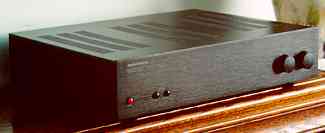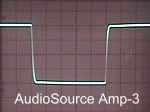Product Review - AudioSource Amp 3 Two
Channel Power Amplifier - February, 1998
J.E. Johnson, Jr.
![]()
 |
AudioSource Amp 3, Two-Channel
Power Amplifier 150 Watts/Channel into 8 Ohms, 400 Watts Bridged Mono Mfr Frequency Response 20 Hz - 20 kHz � 0.5 dB THD 0.04% Size: 4" H x 16 1/2" W x 13 1/4" D Weight: 28 pounds Price: $499 USA |
| AudioSource, 1327 North Carolan Avenue, Burlingame, California 94010; Phone 415-348-8114; Fax 415-348-8083 |
I remember when AudioSource was a very small company, making just a couple of products. Through hard work and obvious success, they are now a relatively large manufacturer of numerous products, including power amplifiers and subwoofers. The Amp 3 is a two-channel power amplifier, designed with home theater in mind. For $499, you get a very simple chassis. On the front are the power switch, speaker switch (Speaker set A and/or B), and volume control for each channel. On the rear are line in and line out (for daisy chaining) RCA jacks, bridging toggle, two sets of 5-way speaker binding posts, and grounded AC socket for the power cord.
The Amp 3 is rated at 150 watts/channel into 8 Ohms. The heavy
toroidal transformer inside is part of the power supply that allows using two pairs of
speakers to be connected at the same time, as long as the combined parallel impedance does
not result in less than 2 Ohms.  Although
you might immediately think of multi-room use with this feature, more importantly, it
implies a solid power foundation for those action film sound tracks. It was this fact,
plus some readers questions about two and three channel power amplfiers for home theater,
and its modest price tag, that prompted me to get the Amp 3 for review.
Although
you might immediately think of multi-room use with this feature, more importantly, it
implies a solid power foundation for those action film sound tracks. It was this fact,
plus some readers questions about two and three channel power amplfiers for home theater,
and its modest price tag, that prompted me to get the Amp 3 for review.
The measured power bandwidth of the Amp 3 review unit (the highest
frequency where the voltage level is down 3 dB from the level measured at 10 kHz) extends
to 250 kHz, although AudioSource uses an output RC network to rolloff at about 85 kHz (in
their latest production units). The 10 kHz � 10V square wave response is very nice too.  Quite impressive for a $499 power amplifier. The advantage
of a wideband capability is good phase response (less phase shift in the audio band than
an amplifier that has a 3 dB down point at, say, 50 kHz). However, if the amplifier is not
stable, and the load is moderately reactive, it will see the capacitance of the load as a
short at high frequencies (the capacitance acts as a high pass filter), and will oscillate
at these high frequencies, causing the amplifier to perform poorly. So, besides the
regular speakers, I put the Amp 3 with our Threshold ES-500 Full Range Electrostatic
Speakers, which are difficult loads. I was pleasantly surprised to find that the Amp 3
handled these tough speakers admirably. The detail and deep bass were there. Clean, no
noise, and enough power to fill the room. Granted, it did not drive the ES-500s to high
levels, but even near clipping, the Amp 3 did not flinch. And this was with such amp
buster CDs as "Fanfare for the Common Man" on Telarc. The amplifier never got
warm, whether using powerful music, stressful sinewaves, or just resting, which suggests
only a tiny bias into Class A to keep the six bipolar output devices in each channel from
ever turning completely off. Cool running characteristics make this amplifier a good one
to consider for custom installers whose clients want more power than what's in most of the
multi-room, multi-channel power amplifiers. There is no remote trigger socket on the Amp
3, but a series of them could be turned on with AC line conditioners that have sequential
activation, such as the Rotel RLC-900 ($200). The power supply of the Amp 3 has four 6,800
�F capacitors with � 62.5 Volts DC on the caps. This provides 53 Joules of energy
storage.
Quite impressive for a $499 power amplifier. The advantage
of a wideband capability is good phase response (less phase shift in the audio band than
an amplifier that has a 3 dB down point at, say, 50 kHz). However, if the amplifier is not
stable, and the load is moderately reactive, it will see the capacitance of the load as a
short at high frequencies (the capacitance acts as a high pass filter), and will oscillate
at these high frequencies, causing the amplifier to perform poorly. So, besides the
regular speakers, I put the Amp 3 with our Threshold ES-500 Full Range Electrostatic
Speakers, which are difficult loads. I was pleasantly surprised to find that the Amp 3
handled these tough speakers admirably. The detail and deep bass were there. Clean, no
noise, and enough power to fill the room. Granted, it did not drive the ES-500s to high
levels, but even near clipping, the Amp 3 did not flinch. And this was with such amp
buster CDs as "Fanfare for the Common Man" on Telarc. The amplifier never got
warm, whether using powerful music, stressful sinewaves, or just resting, which suggests
only a tiny bias into Class A to keep the six bipolar output devices in each channel from
ever turning completely off. Cool running characteristics make this amplifier a good one
to consider for custom installers whose clients want more power than what's in most of the
multi-room, multi-channel power amplifiers. There is no remote trigger socket on the Amp
3, but a series of them could be turned on with AC line conditioners that have sequential
activation, such as the Rotel RLC-900 ($200). The power supply of the Amp 3 has four 6,800
�F capacitors with � 62.5 Volts DC on the caps. This provides 53 Joules of energy
storage.
Well, what about home theater? I connected the Amp 3 to the front left/right pre-outs of our Yamaha RX-V990 receiver, and put on some DVDs. The recent "Terminator 2" DVD release was an excellent test, and the Amp 3 really cranked. Our Krix Esoterix MK-II speakers are a much more friendly load to any amplifier than electrostatics, so I knew that I would get plenty of volume here, but what I was looking for was soundstage. Our Carver AV-705 is quite similar in output rating to the Amp 3, and frankly, I could not tell the difference between the Amp 3 and AV-705, switching one for the other in the front channels. The sound was open and the depth was excellent. The Amp 3 was much better than the built-in power amplifier of all the receivers we had on hand. I expected this, because the Amp 3 has a much more robust power supply and probably a lot less negative feedback than typical mass market receivers. The Amp 3 has a bridging switch that turns it into a 400 watt monoblock, using the left channel input jack, left channel volume control, and the + speaker binding posts of both the left and right channels. This would mean that for $2,500, you could have 400 watts/channel and 5 channels, plenty of power for any home theater (not to mention a total of 60 output transistors!) Don't forget a nice rack that will hold 140 pounds of power amplifiers.
The only complaint I have about this amplifier is the connector plate on the rear. I managed to break one of the input RCA jacks. Of course, we treat review products a little rough because we pass them around to each other and are constantly plugging and unplugging the connectors. But still, this item could use stronger mounting attachments.
In summary, if you are one of our readers who has been looking for a good low cost two channel power amplifier that has simple basic features with no fluff, you should definitely consider the AudioSource Amp 3. For $499, it is one HECK of a deal.
John E. Johnson, Jr.
![]()
� Copyright 1998 Secrets of Home Theater & High
Fidelity
Return to Table of Contents for this Issue.

